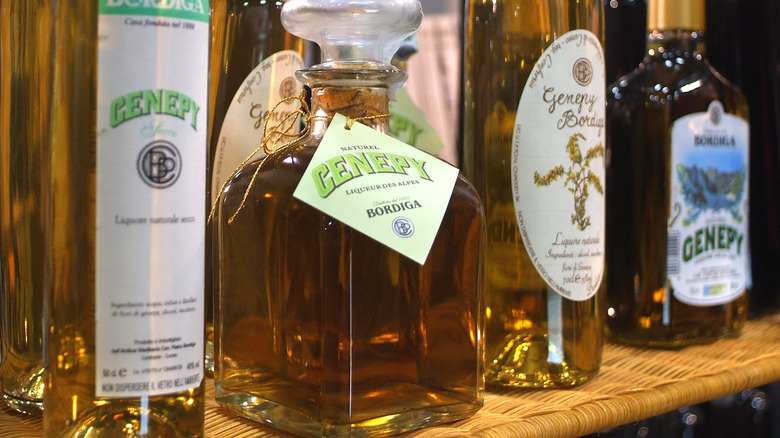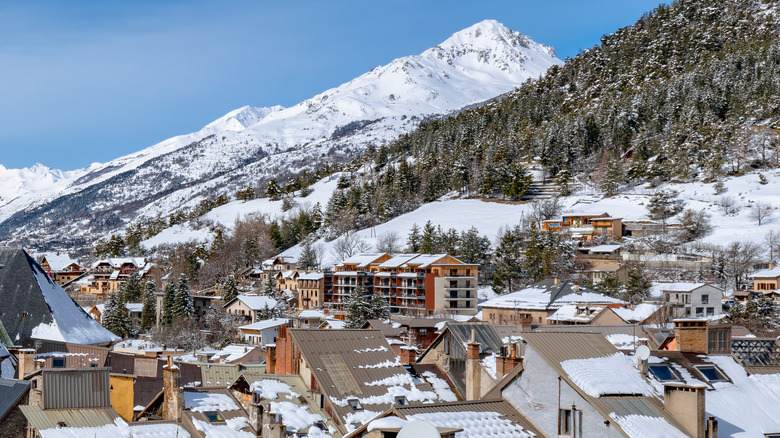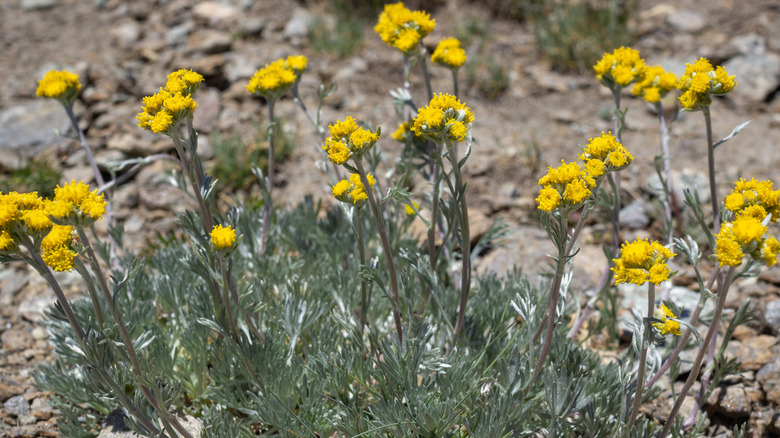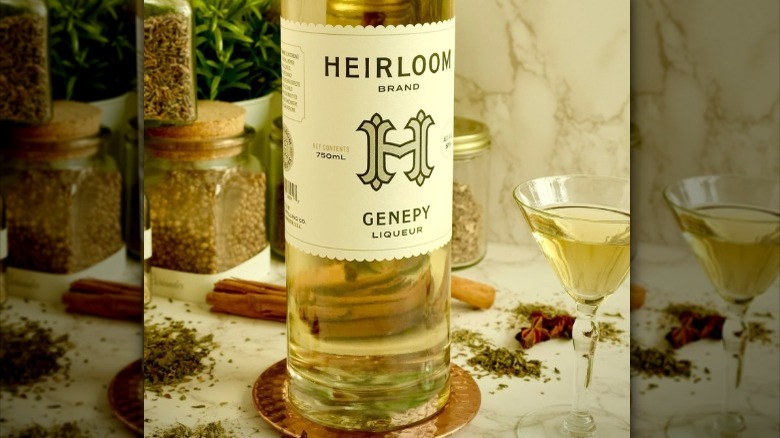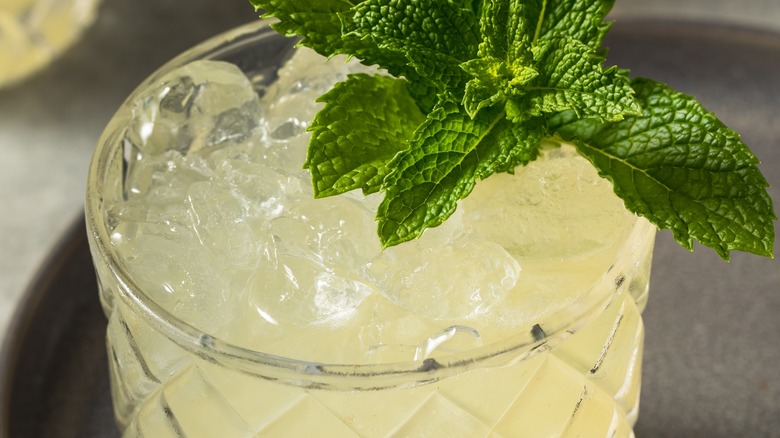Génépi: The Vibrant Herbal Liqueur With A Long History
Nothing screams après-ski quite like a swig of génépi. Seasoned skiers (especially those with the luxury of doing so in Europe) will know that while an active day on the slopes can be fun, the real magic of the mountains happens after retreating inside for an evening of camaraderie and cocktails featuring the infamous alpine apérif, génépi. Although moderation is always key, what happens in the Alps, stays in the Alps.
If you've never heard of this herbal liqueur (written also as génépy, genepy, or genepì), we definitely won't hold it against you. Popularized in the snow-capped regions of Western Europe — namely, Italy, France, and Switzerland — génépi only emerged in the American market a few years ago. However, it's slowly but surely becoming a bar favorite thanks to its refreshingly bittersweet quality that makes it when sipped, served as a shot, or worked into cocktails.
Less intoxicatingly potent than absinthe and more saccharine than Chartreuse, the faded golden-yet-green génépi has an herbaceousness that borders somewhere on floral and botanical. With nuances of mint, licorice, and even chamomile, this sweet spiciness also finds itself on the palate. Like a breath of fresh Alpine air, génépi is sure to become a good addition to any liquor cabinet.
A history rooted in tradition
Much like absinthe, The Washington Post shares that génépi is a type of alcohol flavored with the same ingredient as vermouth, artemisia (or wormwood), usually from any of the species like Artemisia glacialis, Artemisia umbelliformis, Artemisia spicata, Artemisia nivalis, and Artemisia eriantha. Though the plant can be grown all through the glacial terrain of the Alps, the liqueur is most commonly produced in France as Génépi des Alpes, or in Italy as Genepì del Piemonte and Genepì della Valle D'Aosta — all of which boast geographical indications.
Despite the fact that the origin story of génépi is somewhat blurry, the liqueur likely traces back to the same Carthusian monks that developed Chartreuse over 400 years ago. Initially meant as a medicinal elixir thanks to its many healing properties, the aromatic concoction was prized among mountain dwellers also for its ability to relieve altitude sickness, settle an upset stomach, and even lower fevers.
As for when génépi transformed into a pleasurable cordial, while distillation of Génépi des Alpes is thought to have begun in Piedmont's Occitan Valleys during the late 18th century, small-scale production really began almost a century later where it was initially only distributed locally until winter sport tourism (especially from the 1960s onwards) led to a demand in génépi as a post-ski pleasure.
Making the herbal and honeyed génépi
Crafting génépi requires a few key ingredients — like the dried flowers and stems of the artemisia plant and neutral alcohol, along with a mixture of sugar and water. Although a simple maceration of artemisia will highlight the floral qualities of the herb, sometimes other botanicals are added to amp up complexity. For example, Genepì del Piemonte IGP can include trace amounts of herbs like angelica, juniper, lemon balm, mint, rosemary, St. John's Wort, sambuca, thyme, or vervain.
Despite the fact that methods may vary depending on where génépi is made, generally, processing remains fairly similar. Once artemisia is placed in vats of hydroalcoholic solution and left to macerate for several weeks, the mixture is then pressed, combined with sugar and water, and left to age before being filtered and refined. The resulting génépi is naturally colored a greenish gold, unlike colorless génépi that can be made by a much lengthier process where plants are suspended over a hydroalcoholic solution.
Interestingly, while some génépi might be made following the "rule of 40" — 40 flowers, 40 sugar cubes, and 40 days of maceration to produce a spirit of 40% ABV — some cordials can have as little as 25% ABV or as high as 42% ABV. Whichever you decide to sip is totally up to you; however, there are some things to remember when shopping for the liqueur.
What to look for when buying génépi
Due to the medicinal overuse of artemisia in the past, The Washington Post explains that harvesting is now heavily regulated, which means that distilleries mainly rely on cultivated varieties. But, that isn't to say that these génépi isn't still an excellent expression of terroir and quality. In fact, the only indication of a lower quality liqueur would be one that's brightly colored — as they often contain additives. So, where can you find the best génépi?
Given that many distilleries producing génépi are still based in Europe's mountainous regions, this can make locating the grassy liqueur at your local liquor store challenging. While Dolin's Génépy (also labeled as Génépy des Alps) has been a fixture in France since 1821, Liquor.com explains that the liqueur only made its American debut in 2015. That said, even brands like the floral Guillaumette or earthy Distilleria Alpe have since become available to Americans. Not to mention that you can also buy the liqueur on an e-commerce platform or directly from a distillery.
Surprising as it may sound, there are even variations of génépi being crafted on American turf, like the Chartreuse-adjacent Génépi from Aerodrome Distilling and the sweet Genepy from Heirloom Liqueurs. Whichever you decide to try first, always remember that the tipple is best kept in a cool place away from direct light.
How to best enjoy génépi
Génépi is definitely the "it drink" when it comes to après-ski partying. Often served on the rocks in a Cognac glass or as a highball with tonic water and lemon — citrus make génépi sing — locals might even occasionally throw a splash into hot cocoa. But, that's not the only thing that the liqueur is good for.
Sweet yet savory with notes of citrus, spice, and faint vanilla nuances, génépi can be quite complimentary in cocktails such as a White Negroni or a Whiskey Sour. However, it can just easily be worked into any highball, as well as make a viable stand-in for drinks made with Chartreuse.
When it comes to pairing génépi with food, the richer and more luxurious, the better. In fact, the powerful potion is a great match with anything from charcuterie to chocolate, and even pasta. Of course, after dinner, Distilleries et Domaines de Provence recommends pouring génépi over a palate-cleansing sorbet or even drizzling it into coffee. However, if you've eaten far too much following a post-fondue feast, génépi (served neat) also makes an amazing digéstif.
At the end of the day, the sky's the limit as long as you have a bottle of génépi and a little bit of imagination!
